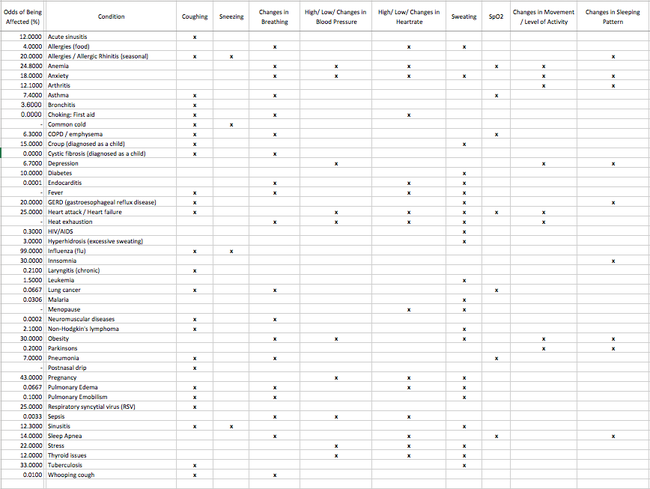This is the wearable diagnostic platform that can do it (almost) all with just a handful of sensors.
July 6, 2016

This is the wearable diagnostic platform that can do it (almost) all with just a handful of sensors.
Nigel Syrotuck
Wearables are a hot ticket item, but what are we actually wearing them for? Most consumer users are focused on fitness, trying to stay healthy by being active and tracking exercise in their daily lives. These are intended to improve your general wellness, a laudable preventative approach to medicine, but are not useful in treating or diagnosing most medical conditions. While these fitness trackers continue to explode into the consumer electronics market, medical wearables are predicted to surpass them in value very soon. Medical wearables--that is, wearables that are intended treat or diagnose medical conditions--will impact the fundamental way we think about medical treatment and diagnostics in the coming years just as fitness wearables have impacted our wellness.
Most existing medical devices are aimed at diagnosing or treating a specific condition. On the flip side, wellness devices are specifically designed to give you general information that can be used to help you monitor a variety of wellness issues. The interesting part is that they accomplish this by monitoring only a few things, such as activity, sleep, and heartrate.
If we combined the two philosophies and imagined a total health platform that could both collect a wide variety of vital statistics for a number of purposes and have it be medically relevant, then medical health could be monitored the same way that general wellness is.
Start planning your fall schedule now. Register for the MD&M Minneapolis Conference, September 21-22. |
It is not even a big step, technologically, to create such a platform using existing, commercially available sensors and supporting technology. Nor is it a great leap forward for the market to accept and understand them after it so willingly adopted fitness wearables. That's a major advantage, considering adoption has been the Achilles heel of many advanced devices. Let's see if just a handful of existing sensors can come together to diagnose and monitor an entire list of medical conditions that affect a vast majority of the population.
As with the start of any good project, let's stop and think about what we might want to accomplish with a total health monitoring platform. First, we would want a list of the most abundant diseases and conditions, so the following is a list of common medical conditions that could be feasibly diagnosed by a non-invasive wearable.


Now, let's aggregate and list all the symptoms of the above conditions and name the sensors we would need to detect and quantify them:


*Note that mood swings themselves have symptoms: changes in vitals, so not listed.
Therefore, with the following five sensors, we could feasibly diagnose at least those 13 common conditions in bold font above:
6-Axis Accelerometer
Blood pressure monitor
Heartrate/ SP02 monitor
Breathing monitor
Skin moisture sensor
Now let's circle back. With those sensors returning quantitative readings of those symptoms, what else can we measure that we might have missed in the first table? The table below shows a number of health conditions with their corresponding symptoms.
(click to enlarge)

And now we see the true conclusion of this exercise: using a platform with just five sensors, we can diagnose 46 of the most common conditions that are likely to affect us, including many of the leading causes of death and chronic illness. As a matter of fact, the odds of any one of us getting at least one of those 46 specific conditions in our lifetime is really high . . . 100% high. If you don't include the things that everyone gets in their lifetime, like colds or postnasal drip, then it's still a greater than 99% chance of developing something off this list.
The total health monitor simply has to collect symptomatic readings and compare them to a table, just like the one above. If a patient is displaying symptoms of coughing, sneezing, and sweating, then they likely have a sinus infection (sinusitis). If they display symptoms of high blood pressure, high heartbeat, and sweating, then they may have be under stress, pregnant, or have a thyroid issue.
By monitoring so many factors, the platform is also able to comparatively diagnosis symptoms and rank them. This can be accomplished by comparing the likelihood of different conditions based on its knowledge base. For example, if I went to the doctor and complained of low blood pressure, and I had an open, bleeding wound, the doctor would probably not diagnose a general problem with low blood pressure. Instead, he or she would stop the bleeding! In the same way, a full picture of multiple symptoms increases the likelihood that an automated diagnostic platform can come to the correct conclusion. In another example, a wearable specifically designed to monitor depression may recognize a reduction in activity as a symptom of depression, but if it could also read other symptoms such as sweating and high blood pressure, then it would return a likely diagnosis of obesity instead. This comparative diagnostic power is a feature that a single purpose device would simply not have.
Sensor Availability: These five sensors are established, available, and relatively inexpensive. Most have been in development for decades and have a firm place in the medical sensor market. In addition, as the MEMS market continues to grow in sales every year, these sensors are likely to be dropping in price. It is also worth noting the lie-detector type of galvanic sensors have been around for a very long time, and they measure mood and mood swings in a noninvasive way. What's more, as the market for wearables, sensors, and embedded components grows, the quality and availability of sensors such as these will go up while the price goes down.
Getting the Data: All this data has to be extracted and processed. Almost by definition, digital health devices need to connect to the cloud to deposit information to the user's health records, provide post market surveillance and allow for updates. Smartphones have been shown to be a good to place to offload the processing and make use of the "free" (or sunk cost) battery-powered wireless computer that goes everywhere the user goes.
Market Advantages: As with any platform that monitors a user's general health information before launching a related medical application, it can also collect data on the other factors to assist in future development. For example, while it is on the market making money as a heart disease monitor, it can collect anonymous data concerning anxiety disorders. With this information, the device can be tuned to monitor anxiety levels, submitted to clinical trials with confidence in success, and then the platform can be sold for two medical indications, and so on.
Very soon, we will start to see multi-function wearables with these capabilities, which will allow patient-consumers to achieve the highest level of preventive care and take charge of their own health in a holistic and affordable way.
|
Nigel Syrotuck is a mechanical engineer at StarFish Medical, a medical device design company headquartered in Victoria, British Columbia.
[Image courtesy of DAVID CASTILLO DOMINICI/FREEDIGITALPHOTOS.NET. Figures courtesy of STARFISH MEDICAL]
You May Also Like



